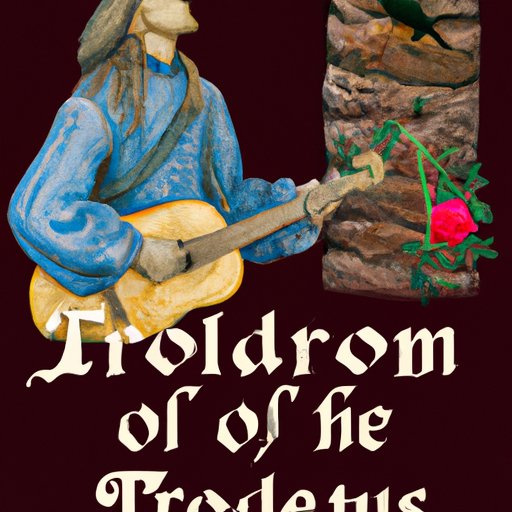Introduction
The Troubadour is a term that is often associated with medieval music and poetry. It has its roots in the French language, and it refers to a poet-musician or poet-singer who composed and performed songs and poems in the Occitan language. The Troubadours were a significant part of the cultural heritage of medieval Europe and contributed significantly to the growth of music and poetry during the Middle Ages. This article aims to explore the history, poetry, and music of the Troubadours and highlight their impact and legacy on modern music and poetry.
The History and Evolution of the Troubadour Tradition
The history of the Troubadour tradition dates back to the 11th century in what is now southern France. At that time, the region was known as Occitania, and it was a hub of trade and commerce. The Troubadours were originally aristocrats who were trained in the art of courtly love and courtship. They composed poems and songs that extolled the virtues of chivalry, love, and romance.
As the Troubadour Tradition grew, it spread throughout Europe, with Troubadours appearing in Spain, Italy, and Germany. The genre began to decline in the early 14th century due to political and social unrest across Europe.
Exploring the Music and Poetry of the Troubadours
The music and poetry of the Troubadours are characterized by their simplicity, elegance, and lyricism. The music was typically composed using a single melody that was sung by the Troubadour. The poetry was often composed using a specific rhyme scheme and meter that gave it a sense of structure and rhythm.
There were two main types of Troubadour poetry: the canso and the sirventes. The canso was a love song that expressed the Troubadour’s feelings of love and devotion towards his beloved. The Sirventes was a political or social commentary that addressed current events or criticized the ruling class.

Famous Troubadours of the Middle Ages: Their Life and Times
Some of the most famous Troubadours of the Middle Ages include Bertran de Born, Arnaut Daniel, and Peire Vidal. These Troubadours were known for their contributions to the genre and their political and social commentary in their poems and songs.
Despite the genre’s decline in the early 14th century, the music and poetry of the Troubadours have left a lasting impact on music and poetry. Their legacy continues to inspire modern musicians and poets.
What Makes Troubadour Poetry and Music Unique: An Analysis
Troubadour Poetry and Music are unique due to their focus on love, romantic ideals, and courtly love. This genre is unlike any other medieval music and poetic tradition because it focuses on the emotions and experiences of the individual rather than religious themes and scripture.
The music and poetry of the Troubadours were experimental and innovative, with many Troubadours pushing the boundaries of their art to create new and exciting works that captivated audiences. Their work paved the way for modern music and poetry, making them significant contributors to the cultural heritage of Europe and the world.
From the Courts of Love to the Modern World: Troubadours and Their Impact
The Troubadours played a significant role in the cultural, political, and social context of medieval Europe. Their music and poetry often reflected the current events and attitudes of the time, providing valuable insights into the era’s values and beliefs.
Their legacy continues to inspire modern musicians and poets, with many contemporary artists drawing upon the themes and motifs of Troubadour Poetry and Music in their work.
Why the Troubadour Legacy Continues to Inspire Artists Today
The influence of the Troubadours can be seen across various art forms, with their legacy inspiring modern artists in unexpected ways. Musicians and poets alike draw upon the themes and motifs of the Troubadours to create new and exciting works that resonate with contemporary audiences.
Furthermore, Troubadour Poetry and Music remain relevant in contemporary socio-cultural environments as they explore the many facets of love, romance, and individuality that continue to shape our world.
Conclusion
The Troubadour Tradition is an integral part of the cultural heritage of Europe and the world. Through their music and poetry, the Troubadours explored the many facets of love, romance, and individuality, paving the way for modern music and poetry.
Studying the Troubadour Tradition provides valuable insights into the cultural, political, and social context of medieval Europe and offers an opportunity to explore the enduring legacy of this significant art form.
If you want to learn more about the Troubadours, we recommend reading the works of Bertran de Born, Arnaut Daniel, and Peire Vidal and listening to the music of Guillaume de Machaut and John Dowland.
